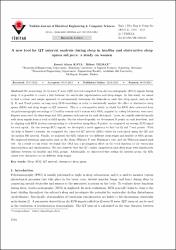| dc.contributor.author | Kaya, Kemal Alican | |
| dc.contributor.author | Yilmaz, Bulent | |
| dc.date.accessioned | 2020-02-07T10:56:10Z | |
| dc.date.available | 2020-02-07T10:56:10Z | |
| dc.date.issued | 2013 | en_US |
| dc.identifier.issn | 1300-0632 | |
| dc.identifier.other | 1303-6203 | |
| dc.identifier.other | 10.3906/elk-1203-62 | |
| dc.identifier.uri | https://hdl.handle.net/20.500.12573/153 | |
| dc.description.abstract | By monitoring the Q wave/T wave (QT) interval computed from electrocardiography (ECG) signals during sleep, it is possible to create a link between the ventricular repolarization and sleep stages. In this study, we aimed to find a robust and simple approach to automatically determine the fiducials on each 30-s sleep epoch, such as the Q, R, and T-end points, on long sleep ECG recordings in order to statistically analyze the effect of obstructive sleep apnea (OSA) and sleep stages on QT intervals. This is a retrospective study in which the ECG data extracted from the polysomnography recordings of 7 healthy women and 5 women with OSA, acquired in a sleep laboratory, were used. Experts annotated the sleep stage and OSA presence information for each 30-s epoch. Later, we visually selected epochs with clean signals from a total of 8324 epochs. On the selected epochs, we determined R peaks on each heartbeat, and by aligning each ECG portion corresponding to a heartbeat using those R points, we computed an average ECG signal for each epoch. On the average ECG signals, we developed a novel approach to find the Q and T-end points. With the help of Bazzet's formula, we computed the corrected QT interval (QTc) values for each epoch using the QT and the median RR interval. Finally, we analyzed the QTc values for the different sleep stages and healthy or OSA groups. We employed statistical approaches such as the Mann-Whitney U test, Freidman's test, and the Wilcoxon signed-rank test. As a result of this study, we found that OSA has a prolongation effect on the total duration of the ventricular depolarization and repolarization. We also observed that the QTc values computed in each sleep stage were significantly different between the healthy and OSA groups. Additionally, we discovered that within the healthy group, the QTc values were distinctive in the different sleep stages. | en_US |
| dc.language.iso | eng | en_US |
| dc.publisher | TUBITAK SCIENTIFIC & TECHNICAL RESEARCH COUNCIL TURKEY, ATATURK BULVARI NO 221, KAVAKLIDERE, ANKARA, 00000, TURKEY | en_US |
| dc.relation.ispartofseries | Volume: 21; | |
| dc.relation.ispartofseries | Issue: 5; | |
| dc.relation.ispartofseries | Pages: 1504-1513; | |
| dc.rights | info:eu-repo/semantics/openAccess | en_US |
| dc.subject | Sleep | en_US |
| dc.subject | ECG | en_US |
| dc.subject | QT interval | en_US |
| dc.subject | obstructive sleep apnea | en_US |
| dc.title | A new tool for QT interval analysis during sleep in healthy and obstructive sleep apnea subjects: a study on women | en_US |
| dc.type | article | en_US |
| dc.contributor.department | AGÜ, Mühendislik Fakültesi, Elektrik & Elektronik Mühendisliği Bölümü | en_US |
| dc.contributor.institutionauthor | | |
| dc.identifier.doi | 10.3906/elk-1203-62 | |
| dc.relation.publicationcategory | Makale - Uluslararası Hakemli Dergi - Kurum Öğretim Elemanı | en_US |


















